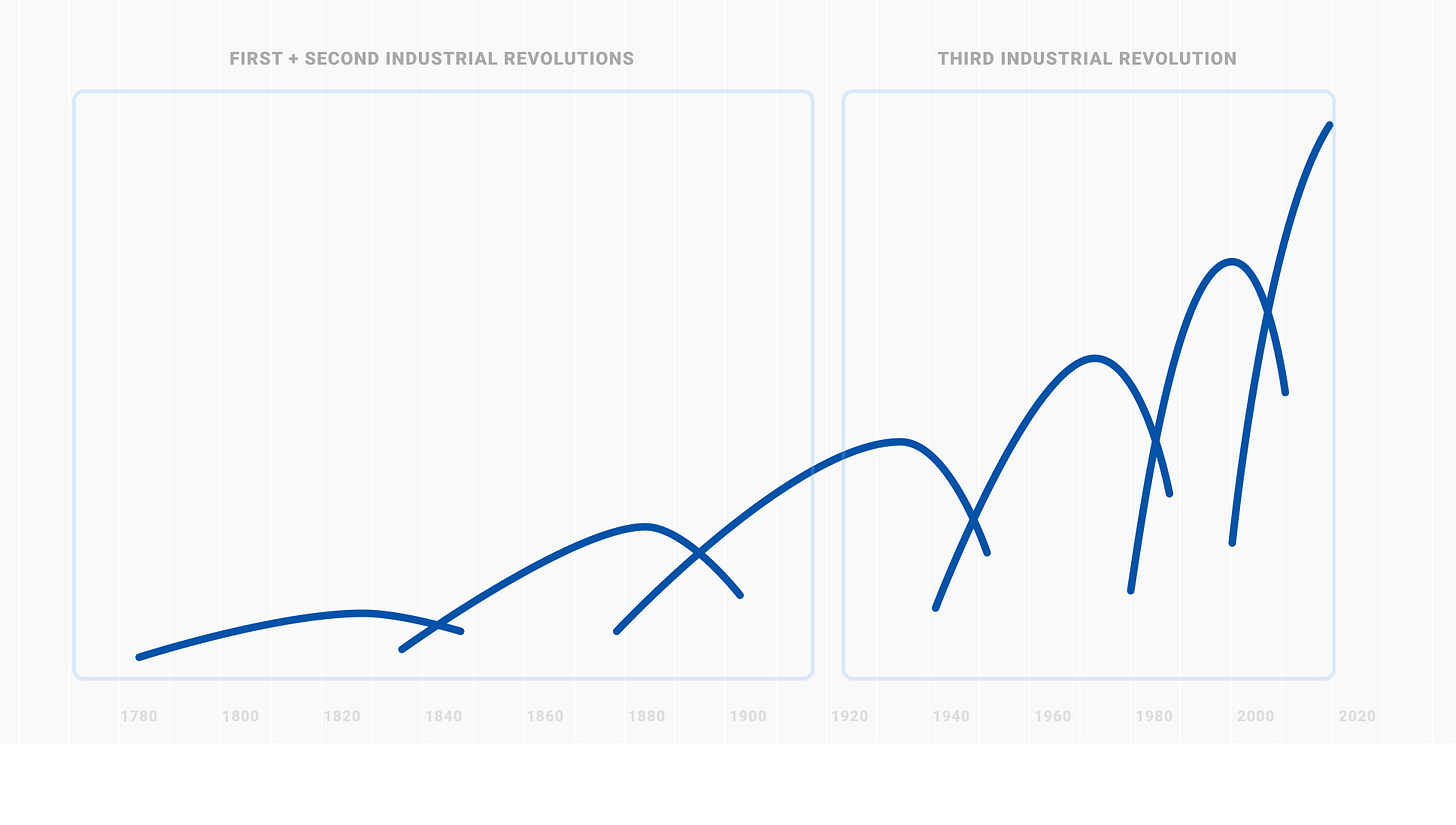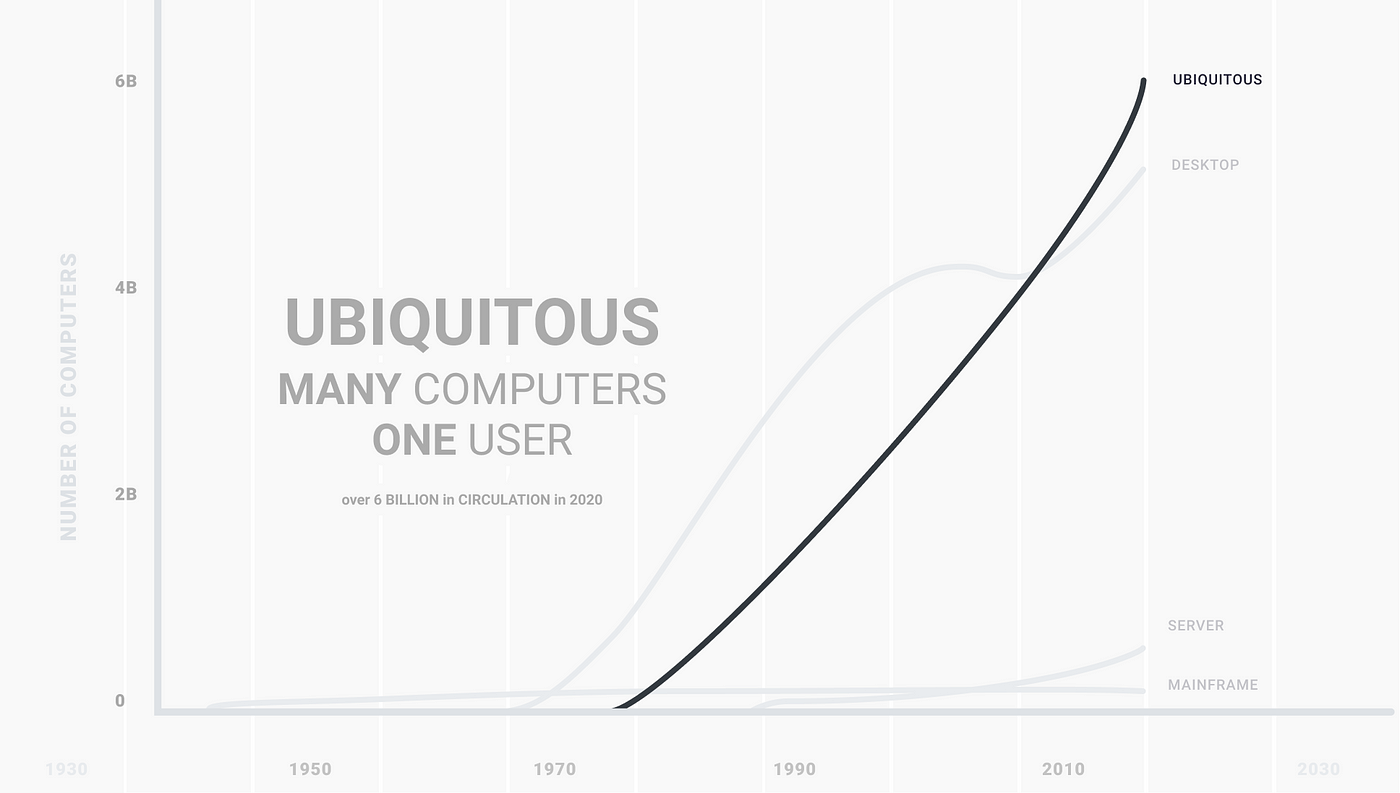A short semantic history of 'Ubiquitous Computing'
Mobile & Spatial Computing and the Concept of Computing Waves
When I was preparing a presentation for this summer’s American Society of Mechanical Engineers conference, a gracious friend was kind enough to listen to me tell the story of how the term ‘Spatial Computing’ is best understood in relation to the three industrial revolution eras, Kondratiev waves of innovation, the misattribution of ‘waves of computing’ to Marc Weiser’s paper The Computer for the 21st Century, and that same paper’s identification of the concept of Ubiquitous Computing.
1. The History
Kondratiev’s waves of innovation, which start at the beginning of the First Industrial Revolution with the invention of the steam engine in the 1780s, were proposed by Soviet economist Nikolai Kondratiev. In his book, The Major Economic Cycles (1925), he proposed a cycle-like economic phenomenon of “waves” that consist of alternating peaks and troughs of sectoral growth and occur in roughly fifty-year increments. Critics of the eponymous K-Waves say the whole concept is apophenia, that the “waves” are a “recognition” of patterns that might not even exist.

Despite the controversy, K-Waves made a big dent in the imagination of technologists and have been leveraged to explain the rapid growth of technological innovation, especially in the last three decades. While I love a good visualization as much as the next info-graphic starved millennial, a close inspection of the myriad of K-Wave graphs found with a quick Google search reveals is a glaring lack of a quantifiable Y-axis.
They do however capture a compelling story of the sub-eras of industrial innovation over the last two centuries.
1st Wave, start 1780s: Steam Engine
2nd Wave, start 1830s: Steel Industry
3rd Wave, start 1880s: Electricity and Chemicals
4th Wave, start 1930s: Automobiles and Petrochemicals
5th Wave, start 1980s: Information Technology
6th Wave, start 2000s: disputed
We are now in the 6th wave, which has been called everything from the wave of Biotechnology to the wave of Sustainability. Time will tell of course, unless we take the critics’ stance and don’t buy into K-Waves whatsoever.
If we zoom into the era of the Third Industrial Revolution, we see a new wave trend emerge; namely, the Three Computing Waves.
This is where the misattribution to Marc Weiser’s 1991 paper The Computer for the 21st Century comes about. (What does certainly happen in that paper, however, is the term ‘Ubiquitous Computing’ is introduced, which we will come back to as it is an important part of understanding Spatial Computing.)
While I have been unable to identify who first propagated this misattribution, one thing is clear, folks have been arguing that there are three waves of computing and like to incorrectly cite Weiser for this observation.
While there are some discrepancies in the titling of each of the three computing waves, there is consistency in terms of the descriptions. Essentially, each wave describes the historical emergence of a computing type in its relationship to how many devices a single user may need or use of that computing type. For example, the Mainframe Computer is best understood as one computer for many users. Whereas the Desktop Computer, sometimes referred to as the Personal Computer (PC), is best understood as one computer for one user.
What these waves, like the K-Waves, seem to miss is any sense of a Y-axis. Once adjusted for approximations of the number of any given computing type in circulation, it is quickly clear that the visualization of Mainframe Computing is far too large, while there is also a gaping lack of a fourth computing type: Server Computing.
When both a Y-axis and Server Computing are added to this wave diagram, a proper graph is created, and with that, the source-less computing wave theory is just a graph of frequencies. (However, there is very little good data on how many computing devices there are by type, so my updated graph has new flaws of its own.)
Computing Types
Mainframe Computing (One Computer, Many Users)
Sever Computing (Many Computers, Many Users)
Desktop Computing (One Computer, One User)
Ubiquitous Computing: (Many Computers, One Users)
Mainframe Computing (One Computer, Many Users), initiated the computing waves in 1944 when IBM’s Automatic Sequence Controlled Calculator (called Mark I by Harvard University’s staff) ran its first program. *Mainframes are used mostly by large international organizations, this type of computing is not needed by everyone. Best guesses are that around 10k mainframe computers are in active use, and while there isn't a huge demand, they are still in production.
Sever Computing (Many Computers, Many Users), is actually the fourth wave of computing. However, it most closely resembles the mainframe in that it is made to be used by many users simultaneously. Most versions of the computing waves do not include this kind of computing, but I argue that this is one of the most critical kinds of computing for the Fourth Industrial Revolution; invisible to the daily user, and yet ever-present (and growing). *There are no reliable data on the number of servers in circulation; the best estimate as of 2020 is around 400,000.
Desktop Computing (One Computer, One User), also called Personal Computing (PC), is when computers are non-mobile and dedicated to a single simultaneous user. Though there has been a recent uptick in sales of Desktop Computers due to the surge in gaming; mostly, these computers are used in business or public services contexts (education, libraries, etc.). While they will likely serve a purpose for another 20 years or so, they are also likely to be the first on this list to disappear completely. *Conservative estimates suggest there are around four billion desktop computers in circulation.
Finally, we get to Ubiquitous Computing aka UbiComp (Many Computers, One User), where the story gets a bit more complicated and Spatial Computing makes its debut. Here is also where Mark Weiser’s paper finally makes an appearance.
“Ubiquitous computers must know where they are… If a computer merely knows what room it is in, it can adapt its behavior in significant ways without requiring even a hint of artificial intelligence”
— Mark Weiser, The Computer for the 21st Century
In my definition of Ubiquitous Computing, there are two computing sub-types: Spatial and Mobile Computing. I will be writing a follow-up article on Spatial Computing. Mobile Computing, needs no follow-up, as we know it well; it comprises devices like laptops, smartphones, and tablets.
If you’ve seen the terms ‘Pervasive Computing’ and ‘Ubiquitous Computing’ used interchangeably, you’re not alone. Ubiquitous Computing means computing found everywhere; whereas Pervasive Computing means computing diffused through everywhere.
And the reason for these semantic specifics?
Dissecting the semantics of interconnected computing terms facilitates mutual understanding and supports literacy for the coming era of the rapidly emerging Fourth Industrial Revolution. For literacy in the 21st century must also be able to distinguish between potatoes and p0tat0es, tomatoes and t0mat0es.
With that, keep on being pedantic.











